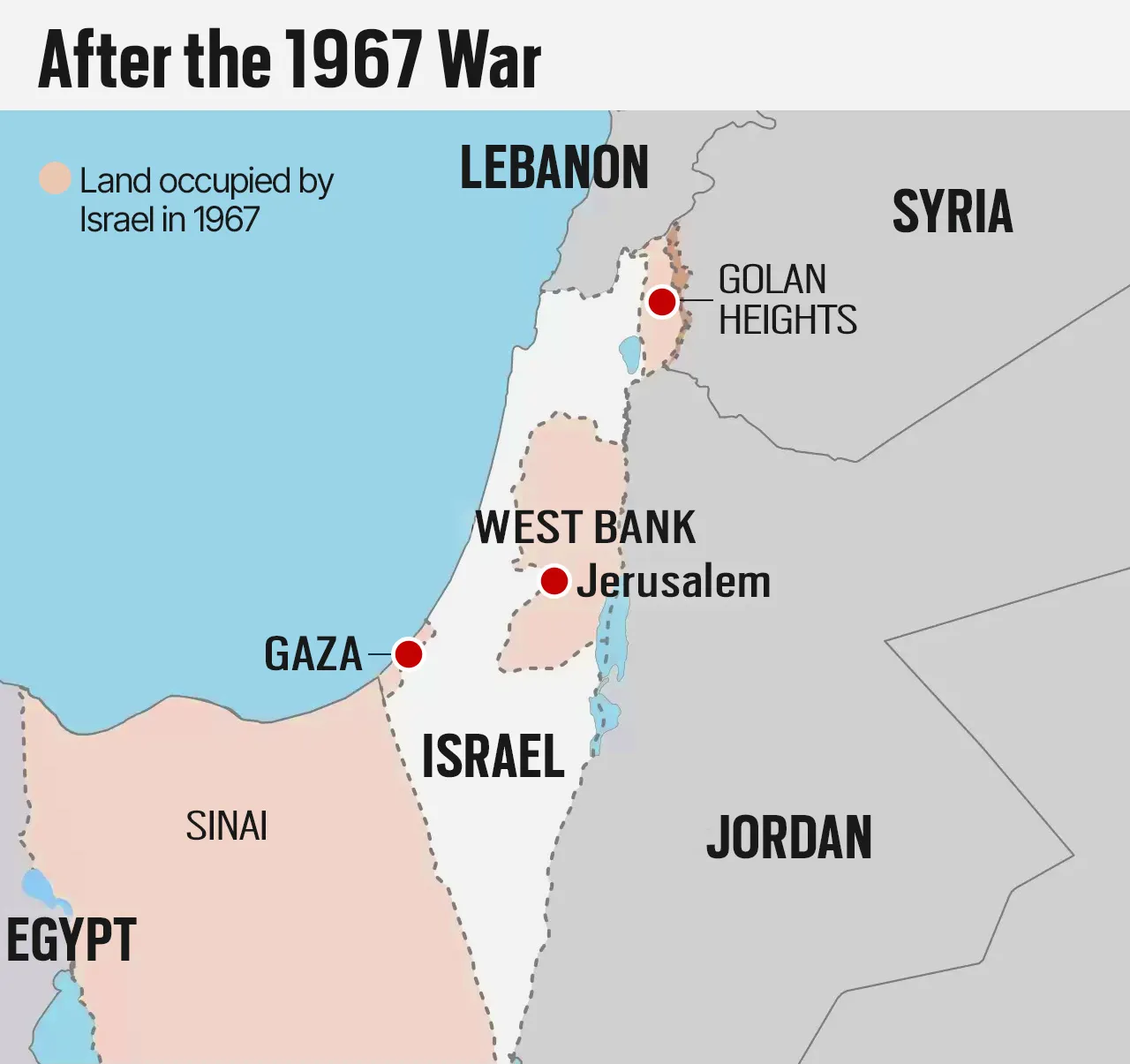Israel-Palestine Conflict
|
For prelims: Israel, Palestine and Arab countries; Zionism, Balfour Declaration (1917), Creation of Israel (1948), Oslo Accords (1993). For Mains: Territorial disputes of Israel, Relationship of India with Israel and impacts on India. |
- The Middle East is on the verge of full-scale war due to the recent Israeli-Iran skirmishes, which have their roots in the Palestine-Israeli conflict.
The conflict between Israel and Palestine is one of the most protracted and contentious issues in international relations. Understanding its history is crucial for comprehending its implications for India and other countries.
History:
The roots of the Israel-Palestine conflict can be traced back to the late 19th and early 20th centuries. The rise of Zionism, a nationalist movement advocating for the establishment of a Jewish state in Palestine, collided with the aspirations of the indigenous Arab population, leading to tensions.
Key events in the history of the conflict include:
- Balfour Declaration (1917): Issued by the British government, this declaration expressed support for the establishment of a “national home for the Jewish people” in Palestine.
- British Mandate (1920-1948): Following World War I, the League of Nations granted Britain control over Palestine. During this period, Jewish immigration increased, further exacerbating tensions with the Arab population.
- Partition Plan (1947): The United Nations proposed a partition plan to divide Palestine into separate Jewish and Arab states. While the Jewish leadership accepted the plan, Arab leaders rejected it, leading to the Arab-Israeli War in 1948.
- Creation of Israel (1948): On May 14, 1948, Israel declared independence, leading to the first Arab-Israeli war. This resulted in the displacement of hundreds of thousands of Palestinians, leading to the creation of a large refugee population.
- Six-Day War (1967): Israel launched a preemptive strike against Egypt, Syria, and Jordan, resulting in the occupation of the West Bank, Gaza Strip, Sinai Peninsula, and Golan Heights. This further complicated the conflict.
- Emergence of Hamas: In 1987, Hamas, a violent offshoot of Egypt’s Muslim Brotherhood, gained power in the Palestinian Authority’s legislative elections and ejected Fatah from Gaza in 2007, dividing the Palestinian movement. Tensions in the West Bank and Gaza escalated in 1987, leading to the First Intifada and a small war between Palestinian militants and Israeli forces.
- Oslo Accords (1993): Signed between Israel and the Palestine Liberation Organization (PLO), the Oslo Accords aimed to establish a framework for peace negotiations and Palestinian self-governance. However, a final resolution remains elusive.
Territorial disputes of Israel with neighbouring countries:
Israel has faced territorial disputes with several neighbouring countries, primarily stemming from conflicting claims over land and borders. The most notable territorial disputes are with:
|
Palestine |
Syria |
Lebanon |
|
|
|

How has the relationship of India with Israel evolved over the years?
- India, a country that opposed the UN’s partition plan in 1947, has shifted its policy towards a dehyphenation of policy. It recognized Israel in 1950 and the Palestine Liberation Organisation (PLO) as the sole representative of the Palestinians. India also recognized the statehood of Palestine in 1988. In recent years, India’s position has been perceived as pro-Israel. India believes in a Two-State Solution for the Israel-Palestine conflict, proposing the right to self-determination to both countries peacefully. This shift towards a dehyphenation of policy has shifted India’s stance on the longest-running conflict in the world.
Implications for India and World Countries:
- International Diplomacy: The Israel-Palestine conflict has significant implications for global diplomacy. Many countries, including India, have taken positions on the conflict based on historical, strategic, and ideological considerations.
- Energy Security: The Middle East, including Israel and Palestine, holds substantial oil and gas reserves. Stability in the region is crucial for ensuring the uninterrupted flow of energy resources, which impacts countries like India, heavily reliant on energy imports.
- Counterterrorism: The conflict has been a rallying point for extremist groups, contributing to regional instability and terrorism. This instability can have far-reaching implications for global security, prompting countries like India to monitor developments closely.
- Humanitarian Concerns: The ongoing violence and humanitarian crisis in Gaza and the West Bank have garnered international attention and raised concerns about human rights abuses. Countries, including India, have called for a peaceful resolution and the protection of civilians.
- Global Geopolitics: The Israel-Palestine conflict intersects with broader geopolitical dynamics, including the influence of regional powers such as Iran and Saudi Arabia. Shifts in alliances and power dynamics in the Middle East can have ripple effects globally.
In conclusion, the Israel-Palestine conflict is a complex issue with deep historical roots and wide-ranging implications for India and other countries. Its resolution remains a significant challenge for the international community, requiring sustained diplomatic efforts and a commitment to justice and peace.
|
During the most recent violent battles over Jerusalem, Israel deployed its Iron Dome air defence system. Important Information About Air Defence system: How does the Israeli air defence system work? · Israel’s air defence system is designed to offer multi-layered defences against various aerial threats, such as aircraft, unmanned aerial vehicles (UAVs), cruise and ballistic missiles. Ballistic missiles travel in a parabolic trajectory, whereas cruise missiles fly close to the ground. Examples of these systems are the nation’s air force’s advanced fighter jets, Iron Dome, Patriot Advanced Capability-2, Arrow 2 and Arrow 3, David’s Sling (Stunner), and others. These systems are engineered to counter particular threats and are integrated to function as a whole to offer complete protection from projectiles. What are the components of Israel’s defence system?
|
